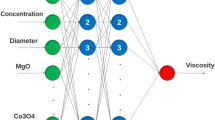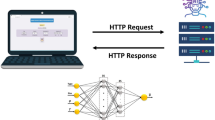Abstract
More than a decade, a numerous experimental and theoretical studies of thermophysical properties of nanofluids are conducted to reveal its heat transfer characteristics. Due to nanofluid unique thermal properties, it is broadly used in various applications from automobile applications to biomedical applications. Despite that various experimental and theoretical studies of nanofluids are developed, the accordance between them is very little and also it is tiresome and expensive. To predict the thermal properties in an easy way, soft computing tools are utilized. In this research work, dynamic viscosity ratio of Al2O3/H2O is predicted using machine learning techniques like multilayer perceptron and Gaussian process regression. In the proposed multilayer perceptron—artificial neural network model, varying a range of neurons in the hidden layer and using Levenberg–Marquardt as training function, it is found that 6 neurons in the hidden layer give less root mean square error value of 0.01118. Different kernel functions are opted to train the proposed Gaussian process regression model, and it is found that Matern kernel function shows the best performance with less root mean square error value of 0.018, and regression coefficient value of both the models is 0.99. This research work will reduce the experimental test run cost, and the models are accurate in prediction.















Similar content being viewed by others
Abbreviations
- GPR:
-
Gaussian process regression
- DVR:
-
Dynamic viscosity ratio
- MLP:
-
Multilayer perceptron
- ANN:
-
Artificial neural network
- H2O:
-
Water
- Al2O3 :
-
Alumina oxide
- RMSE:
-
Root mean square error
- NMSE:
-
Normalized mean square error
- MAPE:
-
Mean absolute percentage error
- R 2 :
-
Regression coefficient value
- MSE:
-
Mean squared error
- MAE:
-
Mean absolute error
- µ p :
-
Dynamic viscosity ratio of predicted data
- µ a :
-
Dynamic viscosity ratio of experimental data
- \(\bar{\mu }_{\text{a}}\) :
-
Mean value of dynamic viscosity ratio of experimental data
- n :
-
Total number of data samples
- T :
-
Temperature (K)
- ɸ :
-
Volume fraction
- D :
-
Size of nanoparticle (nm)
- σ :
-
Standard deviation
References
Das SK, Choi SU, Patel HE. Heat transfer in nanofluids—a review. Heat Transf Eng. 2006;27(10):3–19.
Kumar PM, Kumar J, Tamilarasan R, Sendhilnathan S, Suresh S. Review on nanofluids theoretical thermal conductivity models. Eng J. 2015;19(1):67–83.
Adelekan DS, Ohunakin OS, Gill J, Atayero AA, Diarra CD, Asuzu EA. Experimental performance of a safe charge of LPG refrigerant enhanced with varying concentrations of TiO2 nano-lubricant in a domestic refrigerator. J Therm Anal Calorim. 2019;136:2439–48.
Cacua K, Murshed SS, Pabón E, Buitrago R. Dispersion and thermal conductivity of TiO2/water nanofluid effects of ultrasonication, agitation and temperature. J Therm Anal Calorim. 2019. https://doi.org/10.1007/s10973-019-08817-1.
Hekmatipour F, Jalali M. Application of copper oxide–thermal oil (CuO–HTO) nanofluid on convective heat transfer enhancement in inclined circular tube. J Therm Anal Calorim. 2019;136:2449–59.
Nematpour Keshteli A, Sheikholeslami M. Effects of wavy wall and Y-shaped fins on solidification of PCM with dispersion of Al2O3 nanoparticle. J Therm Anal Calorim. 2019. https://doi.org/10.1007/s10973-019-08807-3.
Barewar SD, Chougule SS, Jadhav J, Biswas S. Synthesis and thermo-physical properties of water-based novel Ag/ZnO hybrid nanofluids. J Therm Anal Calorim. 2018;134:1493–504.
Solangi KH, Sharif S, Nizamani B. Effect of tube material on convective heat transfer of various nanofluids. J Therm Anal Calorim. 2019. https://doi.org/10.1007/s10973-019-08835-z.
Einstein A. Eineneuebestimmung der molekuldimensionen. Ann Phys. 1906;324(2):289–306.
Batchelor GK. The effect of Brownian motion on the bulk stress in a suspension of spherical particles. J Fluid Mech. 1977;83(01):97–117.
Brinkman HC. The viscosity of concentrated suspensions and solutions. J Chem Phys. 1952;20(4):571.
Kitano T, Kataoka T, Shirota T. An empirical equation of the relative viscosity of polymer melts filled with various inorganic fillers. Rheol Acta. 1981;20(2):207–9.
Tseng WJ, Chen C-N. Effect of polymeric dispersant on rheological behavior of nickel–terpineol suspensions. Mater Sci Eng, A. 2003;347(1):145–53.
Pak BC, Cho YI. Hydrodynamic and heat transfer study of dispersed fluids with submicron metallic oxide particles. Exp Heat Transf Int J. 1998;11(2):151–70.
Namburu PK, et al. Numerical study of turbulent flow and heat transfer characteristics of nanofluids considering variable properties. Int J Therm Sci. 2009;48(2):290–302.
Abu-Nada E. Effects of variable viscosity and thermal conductivity of Al2O3–water nanofluid on heat transfer enhancement in natural convection. Int J Heat Fluid Flow. 2009;30(4):679–90.
Mukesh Kumar PC, Kumar J, Suresh S. Review on nanofluid theoretical viscosity models. Int J Eng Innov Res. 2012;1(2):2277–5668.
Papari MM, Yousefi F, Moghadasi J, Karimi H, Campo A. Modeling thermal conductivity augmentation of nanofluids using diffusion neural networks. Int J Therm Sci. 2011;50:44–52.
Esfe MH, Motahari K, Sanatizadeh E, Afrand M, Rostamian H, Ahangar MRH. Estimation of thermal conductivity of CNT-water in low temperature by artificial neural network and correlation. Int Commun Heat Mass Transf. 2016;76(7):376–81.
Longon G, Zilio C, Ceseracciu E, Reggiani M. Application of artificial neural network (ANN) for the prediction of thermal conductivity of oxide–water nanofluids. Nano Energy. 2012;1:290–6.
Vaferi B, Samimi F, Pakgohar E, Mowla D. Artificial neural network approach for prediction of thermal behavior of nanofluids flowing through circular tubes. Powder Technol. 2014;267:1–10.
Esfe MH, Kamyab MH. Viscosity analysis of enriched SAE50 by nanoparticles as lubricant of heavy-duty engines. J Therm Anal Calorim. 2019. https://doi.org/10.1007/s10973-019-08698-4.
Ahmadloo E, Azizi S. Prediction of thermal conductivity of various nanofluids using artificial neural network. Int Commun Heat Mass Transf. 2016;74:69–75.
Afrand M, Toghraie D, Sina N. Experimental study on thermal conductivity of water-based Fe3O4 nanofluid: development of a new correlation and modeled by artificial neural network. Int Commun Heat Mass Transf. 2016;75:262–9.
Aminian A. Predicting the effective thermal conductivity of nanofluids for intensification of heat transfer using artificial neural network. Powder Technol. 2016;301:288–309.
Adio SA, Saheed M. Meyer JP Experimental investigation and model development for effective viscosity of Al2O3–glycerol nanofluids by using dimensional analysis and GMDH-NN methods. Int Commun Heat Mass Transf. 2015;65:208–19.
Khairul MA, Hossain A, Saidur R, Alim MA. Prediction of heat transfer performance of CuO/Water nanofluids flow in spirally corrugated helically coiled heat exchanger using fuzzy logic technique. Comput Fluids. 2014;100:123–9.
Dinesh S, Godwin Antony A, Rajaguru K, Vijayan V. Investigation and prediction of material removal rate and surface roughness, in CNC turning of En24 alloy steel. Mech Mech Eng. 2016;20(4):451–66.
Salehi H, Zeinali Heris S, Koolivand Salooki M, Noei SH. Designing a neural network for closed thermosyphon with nanofluid using a genetic algorithm. Braz J Chem Eng. 2011;28(1):157–68.
Alade IO, Oyehan TA, Popoola IK, Olatunji SO, Aliyu B. Modeling thermal conductivity enhancement of metal and metallic oxide nanofluids using support vector regression. Adv Powder Technol. 2018;29(1):157–67.
Kavitha R, Mukesh Kumar PC. A comparison between MLP and SVR models in prediction of thermal properties of nano fluids. J Appl Fluid Mech. 2018;11:7–14.
Kulkarni DP, Das DK, Chukwi DA. Temperature dependent rheological property of CuO nanoparticles suspension. Nanosci Nanotechnol. 2006;6:1150–4.
Masoumi N, Sohrabi N, Behzadmehr A. A new model for calculating the effective viscosity of nanofluids. J Phys D Appl Phys. 2009;42:055501.
Zhao N, Wen X, Yang J, Li S, Wang Z. Modeling and prediction of viscosity of water-based nanofluids by radial basis function neural networks. Powder Technol. 2015;281:173–83.
Juneja M, Gangacharyulu D. Experimental analysis on influence of temperature and volume fraction of nanofluids on thermophysical properties. Int J Emergy Technol Comput Appl Sci. 2013;5:233–8.
Tavman I, Turgut A, Chirtoc M, Schuchmann HP, Tavman S. Experimental investigation of viscosity and thermal conductivity of suspensions containing nanosized ceramic particles. Arch Mater Sci Eng. 2008;34(2):99–104.
Srivastava S, Gaganpreet S. Influence of particle shape on viscosity of nanofluids. AIP Conf Proc. 2013;1512:984–5.
Qiu L, Zhu N, Feng Y, Michaelides EE, Żyła G, Jing D, Zhang X, Norris PM, Markides CN, Mahian O. A review of recent advances in thermophysical properties at the nanoscale: from solid state to colloids. Phys Rep. 2019. https://doi.org/10.1016/j.physrep.2019.12.001.
Rasmussen CE, Williams CKI. Gaussian processes for machine learning. Cambridge: MIT Press; 2006.
Alawi OA, Che Sidik NA, Xian HW, Kean TH, Kazi SN. Thermal conductivity and viscosity models of metallic oxides nanofluids. Int J Heat Mass Transf. 2018;116:1314–25.
Author information
Authors and Affiliations
Corresponding author
Additional information
Publisher's Note
Springer Nature remains neutral with regard to jurisdictional claims in published maps and institutional affiliations.
Rights and permissions
About this article
Cite this article
Mukesh Kumar, P.C., Kavitha, R. Prediction of nanofluid viscosity using multilayer perceptron and Gaussian process regression. J Therm Anal Calorim 144, 1151–1160 (2021). https://doi.org/10.1007/s10973-020-09990-4
Received:
Accepted:
Published:
Issue Date:
DOI: https://doi.org/10.1007/s10973-020-09990-4




